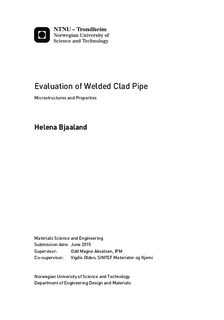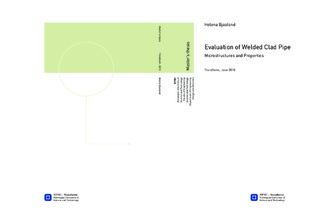| dc.description.abstract | Clad pipes are used in the oil and gas industry for transportation of corrosive substances. Maintenance, repairs and tie-in connections to existing subsea structures is done by hyperbaric welding. There is per today no repair contingency available for clad pipes, so that a knowledge basis must be established in order to maintain pipeline integrity. Welding of clad pipes can result in a variety of complex microstructures due to the presence of dissimilar alloys. The difference in chemical composition and thermal properties will influence the integrity of the welded joint, and may result in a crack susceptible microstructure.
Previous work has shown that carbon migration and subsequent carbide precipitation in the clad, mainly during production, results in a hardened region in the clad. After welding, this region is susceptible to cracking. However, adding a Ni-interlayer between the clad and base metal (BM) provides a solution to the cracking related to the formation of a hard zone in the clad. Nevertheless, cracks may also arise from hydrogen charging from welding or from cathodic protection (CP) or H2S during service, so that the cold cracking mechanisms of clad pipes is still highly relevant.
In this master s thesis, clad pipes with and without a Ni-interlayer have been investigated. The dissimilar interface region and carbides in the clad adjacent to the interface have been investigated using scanning electron microscope (SEM) and transmission electron microscope (TEM). The clad immediately adjacent to the interface contained Cr23C6 carbides, present both inside grains and at grain boundaries. The dissimilar interface showed a jagged distribution of Ni towards the clad side and segregation of Cr to carbides. The dissimilar interface showed a lath-like structure, however, there was no clear evidence of martensite. This should be further investigated.
Slow strain rate (SSR) testing was successfully performed on miniature compact tension (CT) specimens in air and under CP to evaluate the fracture mechanical properties of the dissimilar interface, with respect to material combination and environment. Generally, samples without a Ni-interlayer tested in air showed the highest fracture toughness values, followed by samples with a Ni-interlayer tested in both air and under CP. The lowest fracture toughness values were obtained for samples without a Ni-interlayer tested under CP. Samples with a Ni-interlayer showed an average reduction in CTOD of 7 % in the presence of hydrogen. The minute effect of hydrogen is attributed to the samples failing mainly in the softer Ni-interlayer close to the BM, which has low susceptibility to hydrogen embrittlement (HE). Samples without a Ni-interlayer showed an average reduction in CTOD of 77 % in the presence of hydrogen. The samples failed mainly in the decarburized BM adjacent to the interface, and along the interface. None of the samples failed in the previously suspected crack susceptible region in the clad. Future work should focus on determining the mechanisms behind cracking in the clad by physical weld simulations combined with fracture mechanical testing, and numerical weld simulations to assess any residual stresses. | |

